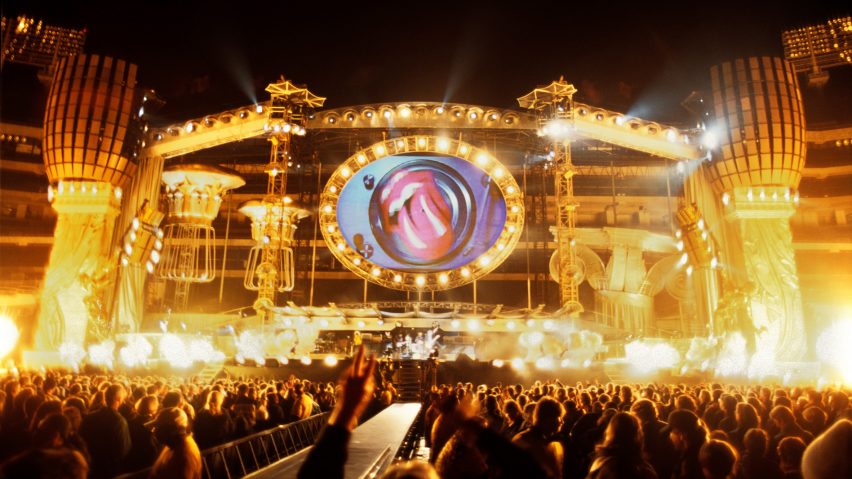
"Mick Jagger is incredibly well informed" about design says Rolling Stones stage architect
Ray Winkler of Stufish has created stages for the Rolling Stones for over 20 years. In an exclusive interview with Dezeen, he explains how set design has changed in the music industry and reveals what it's like to work with the world's biggest rock stars.
A qualified architect, Winkler is CEO and design director of Stufish, a London-based entertainment architecture studio founded by the late, legendary stage designer Mark Fisher.
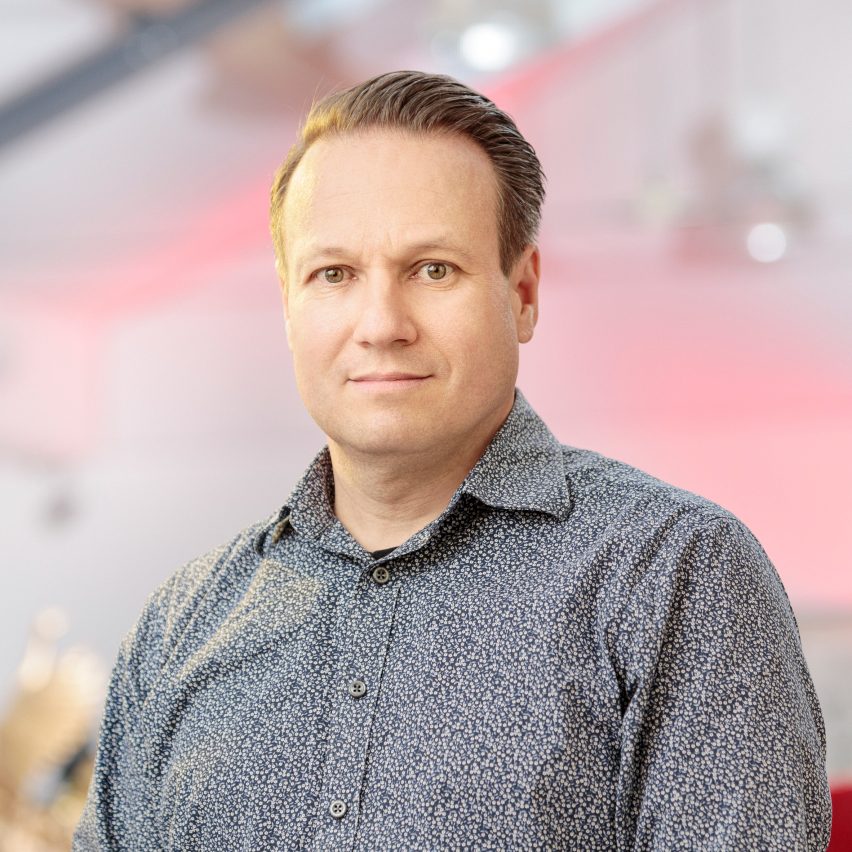
Winkler, 50, has worked with acts including Madonna, U2 and Beyoncé. He has also worked on the design of every Rolling Stones tour since 1996, including the No Filter tour, which began in Hamburg one year ago and ended in Warsaw last month.
With 20 dates across Europe, the No Filter shows were seen by just over 1.5 million people in total. The stage was unusually minimal for a rock group, with four vertical screens and a cantilevered roof.
"We stripped [the stage] down really to the basic minimum," Winkler said. "I remember very clearly the very first sketch was on an A3 piece of paper done with a red sharpie of four slabs and a roof that was floating, and that was pretty much it."
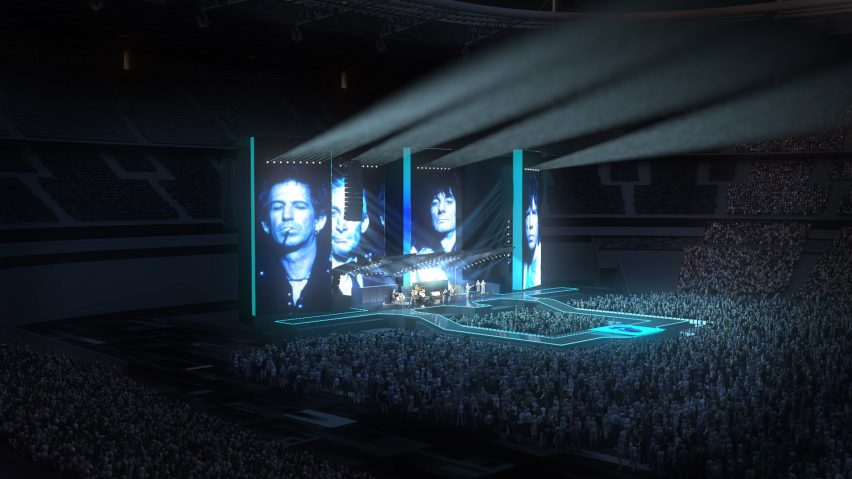
Many pop stars delegate stage design decisions to their teams. But with the Stones, Winkler often deals directly with the band, particularly vocalist Mick Jagger and drummer Charlie Watts.
"In the case with the Stones it's definitely Mick Jagger and Charlie Watts who are very involved in the design process," he said.
"When you meet people like Mick and Charlie in that kind of one-to-one situation they're artists, they want to get a message across. So they don't appear as the pop stars that they are on stage. Mick is incredibly well informed and very articulate."
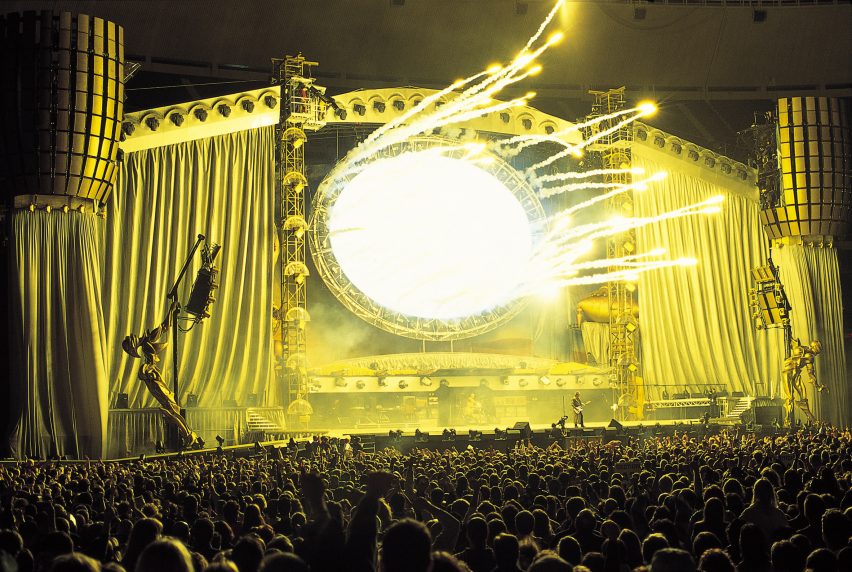
Winkler joined Stufish after graduating from the Bartlett School of Architecture in 1996 and worked his way up, taking over the reins after the death of his mentor, Mark Fisher, in 2013. Through the course of his career he has seen the economics of stadium tours change dramatically.
Previously tours helped bands sell albums; today they are their main source of income. Bespoke stages that required hundreds of trucks have been replaced by modular designs built largely of hired kit. One of the tricks today's stage designers need to pull is to hide these economies from the audience.
"The industry has learnt a lot over the last 20 years of how to maximise the impact of the show and minimise the costs," Winkler said.
Below is a transcript of the interview with Winkler:
Marcus Fairs: Tell us how and when you started working with the Rolling Stones.
Ray Winkler: The first job [Mark Fisher] did for the Stones was the Urban Jungle tour, which was in 1990, but the design work would have started in 1989. It started off in the US as the Steel Wheels tour and then came over to UK as the Urban Jungle tour.
It was when the Rolling Stones first woke up to the fact that there was something called stage architecture, which we knew was coming, because stadium tours were getting more and more complicated. The logistics of travelling from one city to the next became increasingly a challenge, so design had to play a large part in solving these practical problems.
The tour was at the time the biggest tour ever in terms of the sheer volume of stuff that had to be carted around. I think it required somewhere in the order of about 110 trucks to move the Urban Jungle tour from city to city. And that's really when the modern day touring industry was born; where architecture and music came together to present the audience with these fantastic stadium spectacles.
Marcus Fairs: You work with a lot of big acts, but how much face time do you have with the artists themselves?
Ray Winkler: Each artist and each band has its own way of working. Some artists who will have a creative director who they work with very closely and who is usually in charge with the overall vision and represents the band. In the case with the Stones it's definitely Mick Jagger and Charlie Watts who are very involved in the design process. [Lighting designer] Patrick Woodroffe acts as their creative director. He's been with the Stones for a very long time.
A lot of the conversations are directly with the band or passed through Patrick. Our job is to take the artists' vision of what they want to do and translating that into a practical solution without losing any of the energy, vibe and spirit of what they are trying to convey, and translate these ideas into a touring structure.
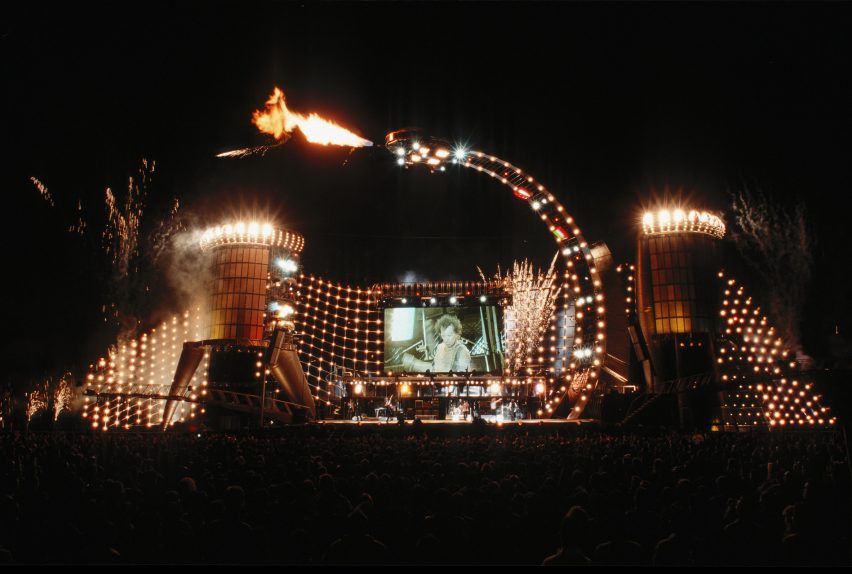
Marcus Fairs: You joined Mark Fisher's studio in 1996. How was it when you first met the Rolling Stones?
Ray Winkler: It was awe inspiring. That was back on the Bridges to Babylon tour, the second job I'd done with Mark, but the third tour that Mark had done for the Stones. We were in a hangar at Toronto airport, and we'd hired that for six weeks of technical rehearsals. It was a very complex show. There was a lot of new things that were being introduced. Bridges to Babylon was obviously referring to the mechanical bridge that was parked sub-stage and that was fraught with a number of challenges to get that working.
When you meet people like Mick and Charlie in that kind of one-to-one situation they're artists, they want to get a message across. So they don't appear as the pop stars that they are on stage. It's a very balanced relationship and it's a very interesting conversation to be had with people, because they've done and seen it all.
Marcus Fairs: I've met someone who met Mick Jagger and said he was the nicest person you'd expect to meet, not at all the swaggering rock star that you might expect.
Ray Winkler: I would second that, absolutely. This is the big difference between the persona they are on stage and the people who they are off stage. Mick is incredibly well informed and very articulate.
Marcus Fairs: Which was the first stage design that you could say was yours?
Ray Winkler: Mark had the relationship with the band. He passed away five years ago, and it was an interesting moment where we basically had to apply for the job again. Nothing is like a job for life. So I went for an interview with Mick, which was interesting, and obviously he clocked that we had been doing every single show for them since the Urban Jungle tour.
Marcus Fairs: What was the interview like? Was it formal?
Ray Winkler: It was a phone interview. It was very professional in that he wanted to know what ideas we had and what we would do to make this show fresh and what sort of challenges that we were facing. Then he talked about his ambitions and his ideas.
We were given the job to do the 14 on Fire tour in 2014, which was the first job we did after Mark had passed away. But from those conversations we developed an idea and become very proactive, throwing ideas back at them, very quickly sketch ideas.
I was a bit nervous, because obviously the relationship was there with Mark and it was a very strong relationship, and it was really a step up for us as a studio to deliver. In the end we delivered very well, the tour was successful and it was a departure from the way they had done things in the past.
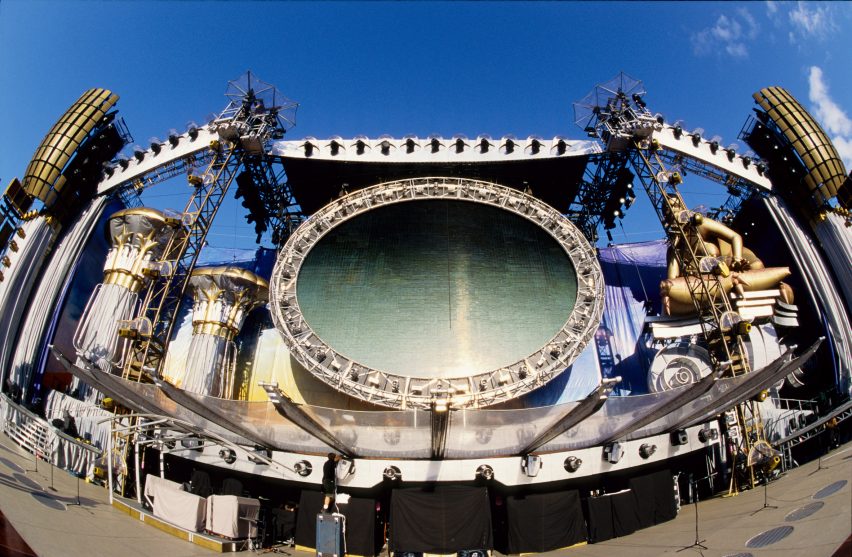
Marcus Fairs: In what way?
Ray Winkler: The way they had done things in the past involved very intricate and bespoke structures. As the touring schedules began to change the business model changed with it, so we started to tour with what we call festival stages. We needed to find interesting ways to adapt those festival stages so that they became bespoke and they looked like they were custom made for the Rolling Stones – where the reality was that 99 per cent of all the stage components were rental stock.
Marcus Fairs: So the business model of big tours changed? What drove that?
Ray Winkler: In the 80s and 90s the Stones, like all bands, went on tour to promote their albums. The money was made through album sales, but with the advent downloading and streaming that changed and put different pressures on the touring industry. The efficiency had to be kicked up, because it's expensive to tour lavish productions.
The Stones were very focused on keeping their name on the road, and alive, but at the same time dealing with the challenges of the 21st century, which meant they probably weren't making much money from selling records any more. so the touring industry became an important income stream for them, and all of the associated income like merchandising.
Marcus Fairs: So in other words, tours went from being a primarily a way of promoting album sales to being the main cash generator in their own right?
Ray Winkler: In the past it wasn't crucial to make large amounts of money from touring because record sales were very healthy, and that's how bands made their income. When that income stream diminished then bands wanted to increase their income stream from another perspective, and that was the touring perspective.
Marcus Fairs: So you had to use generic equipment to build the stage sets to save money, but still make them look unique.
Ray Winkler: Yeah, I mean, look at the visual language of something like Urban Jungle, which was phenomenal in its scale and ambition and the amount of intricate detail that was put into it. And you compare it to the last show that we last did earlier this year: the No Filter tour which was very deliberately stripped down to the bare minimum and spoke a very clean, modernist language. This was in part a style but there also was part in terms of logistics, you know, one takes a whole lot more trucks than the other.
It's not just the Stones that who've done that. Across the board, all the big touring shows are elaborate and they are expensive. The industry has learnt a lot over the last 20 years of how to maximise the impact of the show and minimise the costs.
Marcus Fairs: So take the No Filter tour for example, how did that design come about? Do you have an idea, scribble it on a piece of paper, take a photo and email it to Mick Jagger? Is that how it works?
Ray Winkler: Yeah literally that. The No Filter tour was very unique in that we seemed, between Patrick and us to have nailed really really quickly what the concept was. You start off by looking at what the Stones have already done and then you quickly come to the question of what have they not done? And the one thing they hadn't done was a very simple, modernist design.
The Stones are known for very large productions. So if you take it down to the bare minimum and analyse what rock and roll stages do, you have one large horizontal plane, which is the stage surface, and you have one large vertical plane which is the backdrop with video, lighting, pyro-effects, and everything else that goes for a show. And somewhere between those vertical and horizontal, you have another plane, which is usually the roof cover, and those became the three elements we played with. We stripped them down really to the basic minimum.
Rather than dealing with the backdrop like a lot of the bands do – take for example U2's Joshua Tree tour, where the video wall become just one large huge monolithic backdrop – we flipped it, and turned it into characters that reference the four principle band members. We also make them more three-dimensional. So not just a flat surface: we give them a return so that the LEDs can wrap around the edges so they look more like the monolith in 2001: A Space Odyssey.
Then we started to play with the composition of that, how far apart they should be, and in the end that sort of all come in organically. I remember very clearly the very first sketch was on an A3 piece of paper done with a red sharpie of four slabs and a roof that was floating, and that was pretty much it.
The band bought into that pretty quickly. To our surprise they stuck with it, because what often happens in these conversations is that ideas get elaborated and then you lose focus of what the initial idea was, and then you go off on a tangent only to find yourself coming back again to the same idea, reinvestigating, deconstructing and then putting it together again and in the end it's something completely different. In the case of the No Filter tour it was pretty consistent from the very first sketch to the final piece.
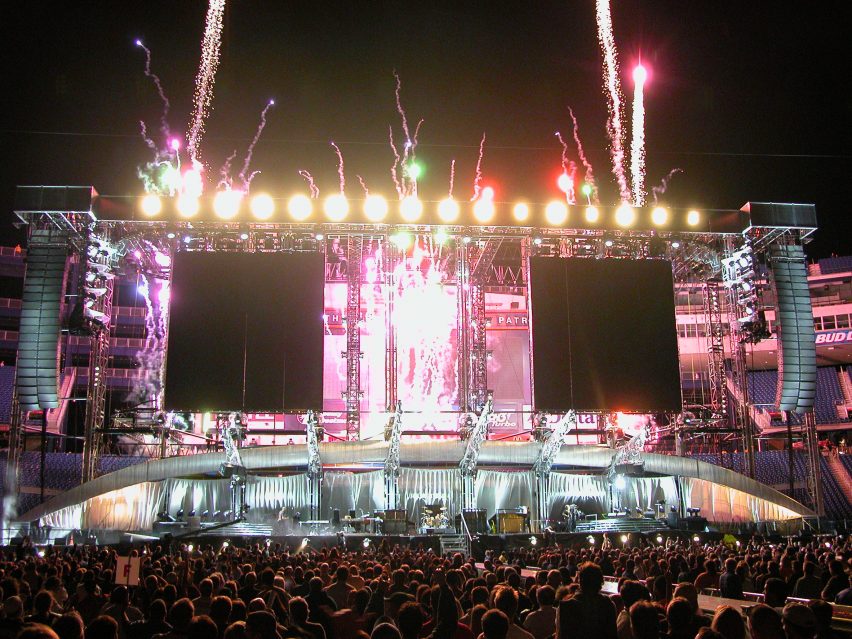
Marcus Fairs: So the four vertical monoliths represent the four band members?
Ray Winkler: Yeah that was the idea. Then we stripped everything back till there was nothing superfluous. We were very conscious about removing the look of the set, away from the usual rock and roll vernacular which is often a lot of exposed trussing, a lot of hardware, clamps and lights and things that move, cables and chains, and all of those things add to the cacophony of a big rock and roll tour.
It was very important that none of that appeared to intercept, in particular during daylight, which is an important factor in the design of shows like this when bands tour northern Europe in the summer – maybe only the last fifth of the show is actually in darkness, so it has to stand its ground during daylight.
So we were very careful in masking all the trussing, we were very careful with the eight 12-metre cantilevered fingers that hold up the roof, to conceal all of the cabling that lead to the lights. The lights were all embedded in these cantilevered fingers. All the drain pipes, all the roof skin, all the shackles, everything was just tucked away and so it looked very simple.
The irony is that it was very complicated to achieve that visual simplicity. The method for assembling these things needs to be considered too, so you don't end up with a big cable hanging across the video screen, or hanging right behind Charlie, because that's what often happens in these rock and roll shows. And it's just accepted. It's the language of rock and roll; it's very masculine and it's often quite crude.
Marcus Fairs: So it's more akin to architecture than regular stage design?
Ray Winkler: Absolutely. We approached it very much from an architectural perspective.
Marcus Fairs: What was the most challenging stage design you've worked on?
Ray Winkler: Bridges to Babylon. As the name suggests, there was a bridge involved. It was this amazing cantilevered fireman's ladder that went from underneath the main stage and connected to the B stage – the smaller stage set amid the audience about 50 metres away – with no apparent connection when it was tucked away. What normally happens is you connect the A stage to the B-stage with a walkway, a catwalk.
But instead of having that catwalk and a means of getting from one to the other, we had a bridge connected the band to the B-stage. And we didn't have this bridge for the first three shows because it failed its factory test and spectacularly collapsed. All you can say then is "oh f*ck!" and stand there and scratch your head.
Of course we're quite happy that it happened here and not in show condition. It was a fairly straightforward mechanical failure on a weak spot. A few shows into the tour the bridge did appear spectacularly and was very well received, but for me personally it was just a really exciting moment, not just because it was at the beginning of my career but also when you realise everything that we do and have done since is always only a prototype.
We don't have the luxury of going out and spending a year on designing something in the hope that we can achieve something. It's usually a phone call and then we get on with doing it. By the time that it appears on stage it is a prototype that hasn't existed before.
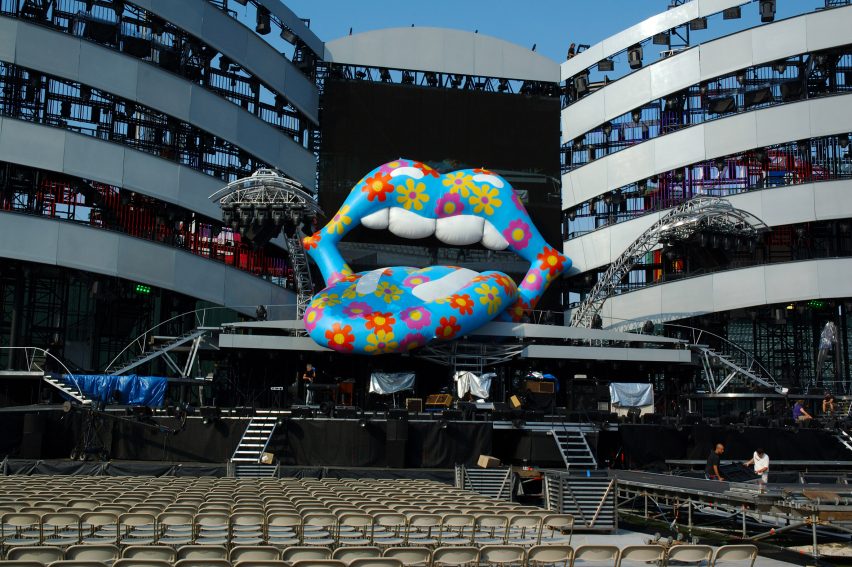
Marcus Fairs: You mentioned factory tests. Presumably that's when you build a full-size stage in a hangar and test it and get all the safety approvals. But how do you get approval for something that has to move between different countries?
Ray Winkler: What normally happens is that the stage will be built in full scale so everybody in the crew knows what's going together. They will rehearse that, they will put it together, take it apart again and put it away. So at that point you find a lot of the teething problems.
As far as the sign-off process is concerned, it's very rigorous. What we normally do, when it tours in Europe, is follow the German DIN (Deutsches Institut für Normung) standards for building codes, which deal with structure, with fire regulations, with everything that makes a temporary structure safe, because they're the most stringent ones. They're widely accepted throughout Europe. There are certain areas where you have to get secondary approval.
You have an advanced crew that go out and prep the site before the actual show arrives. They will have had weeks of advance conversations with the local authorities via the promoter who promotes the show locally as to what is allowed and what isn't allowed. It's a well-rehearsed process. It's very important to say that there's nothing rock and roll about health and safety. That is really strict. There's no fuzzy edges to the health and safety aspects of any of this.
Marcus Fairs: Do you always go to the opening night? Do you go to the afterparty and hang out with the band, or back to the office to work on the next project? How rock and roll is your lifestyle?
Ray Winkler: That is a good question! How do you define rock and roll? Is it the 1970s rock and roll or the 2000s rock and roll? Because things have changed dramatically. By the time it gets to opening night usually everybody is pretty exhausted because there's a lot of work that goes into that.
In the case of the Rolling Stones, they've always been very, very generous with how they treat their crew and also how they treat their fans. So they have great after-show party as well as lots of pre-show facilities. They cater for a large amount of people who've contributed to the industry as well as friends and family. It's relaxed and it's very nice.
What's great about the touring industry is that it's a bit like the circus. It's a very large family with lots of people, like distant relatives that you've come across over and over again. It's actually a very small industry.